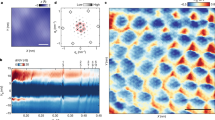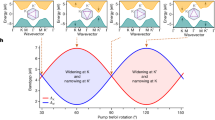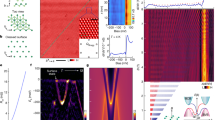Abstract
Interlayer excitons (ILXs) — electron–hole pairs bound across two atomically thin layered semiconductors — have emerged as attractive platforms to study exciton condensation1,2,3,4, single-photon emission and other quantum information applications5,6,7. Yet, despite extensive optical spectroscopic investigations8,9,10,11,12, critical information about their size, valley configuration and the influence of the moiré potential remains unknown. Here, in a WSe2/MoS2 heterostructure, we captured images of the time-resolved and momentum-resolved distribution of both of the particles that bind to form the ILX: the electron and the hole. We thereby obtain a direct measurement of both the ILX diameter of around 5.2 nm, comparable with the moiré-unit-cell length of 6.1 nm, and the localization of its centre of mass. Surprisingly, this large ILX is found pinned to a region of only 1.8 nm diameter within the moiré cell, smaller than the size of the exciton itself. This high degree of localization of the ILX is backed by Bethe–Salpeter equation calculations and demonstrates that the ILX can be localized within small moiré unit cells. Unlike large moiré cells, these are uniform over large regions, allowing the formation of extended arrays of localized excitations for quantum technology.
This is a preview of subscription content, access via your institution
Access options
Access Nature and 54 other Nature Portfolio journals
Get Nature+, our best-value online-access subscription
$29.99 / 30 days
cancel any time
Subscribe to this journal
Receive 51 print issues and online access
$199.00 per year
only $3.90 per issue
Buy this article
- Purchase on Springer Link
- Instant access to full article PDF
Prices may be subject to local taxes which are calculated during checkout




Similar content being viewed by others
Data and materials availability
All data are available in the main text or the Supplementary Material.
References
Wang, Z. et al. Evidence of high-temperature exciton condensation in two-dimensional atomic double layers. Nature 574, 76–80 (2019).
Wang, J. et al. Optical generation of high carrier densities in 2D semiconductor heterobilayers. Sci. Adv. 5, eaax0145 (2019).
Li, W., Lu, X., Dubey, S., Devenica, L. & Srivastava, A. Dipolar interactions between localized interlayer excitons in van der Waals heterostructures. Nat. Mater. 19, 624–629 (2020).
Kremser, M. et al. Discrete interactions between a few interlayer excitons trapped at a MoSe2–WSe2 heterointerface. Npj 2D Mater. Appl. 4, 8 (2020).
Yu, H., Liu, G.-B., Tang, J., Xu, X. & Yao, W. Moiré excitons: from programmable quantum emitter arrays to spin–orbit-coupled artificial lattices. Sci. Adv. 3, e1701696 (2017).
Liu, X. & Hersam, M. C. 2D materials for quantum information science. Nat. Rev. Mater. 4, 669–684 (2019).
Kennes, D. M. et al. Moiré heterostructures as a condensed-matter quantum simulator. Nat. Phys. 17, 155–163 (2021).
Rivera, P. et al. Interlayer valley excitons in heterobilayers of transition metal dichalcogenides. Nat. Nanotechnol. 13, 1004 (2018).
Tran, K. et al. Evidence for moiré excitons in van der Waals heterostructures. Nature 567, 71–75 (2019).
Seyler, K. L. et al. Signatures of moiré-trapped valley excitons in MoSe2/WSe2 heterobilayers. Nature 567, 66–70 (2019).
Karni, O. et al. Infrared interlayer exciton emission in MoS2/WSe2 heterostructures. Phys. Rev. Lett. 123, 247402 (2019).
Zhang, L. et al. Highly valley-polarized singlet and triplet interlayer excitons in van der Waals heterostructure. Phys. Rev. B 100, 041402 (2019).
Fogler, M. M., Butov, L. V. & Novoselov, K. S. High-temperature superfluidity with indirect excitons in van der Waals heterostructures. Nat. Commun. 5, 4555 (2014).
Wu, F., Lovorn, T. & MacDonald, A. H. Theory of optical absorption by interlayer excitons in transition metal dichalcogenide heterobilayers. Phys. Rev. B 97, 035306 (2018).
Jin, C. et al. Identification of spin, valley and moiré quasi-angular momentum of interlayer excitons. Nat. Phys. 15, 1140–1144 (2019).
Jin, C. et al. Observation of moiré excitons in WSe2/WS2 heterostructure superlattices. Nature 567, 76–80 (2019).
Gillen, R. & Maultzsch, J. Interlayer excitons in MoSe2/WSe2 heterostructures from first principles. Phys. Rev. B 97, 165306 (2018).
Shabani, S. et al. Deep moiré potentials in twisted transition metal dichalcogenide bilayers. Nat. Phys. 17, 720–725 (2021).
Man, M. K. L. et al. Experimental measurement of the intrinsic excitonic wave function. Sci. Adv. 7, eabg0192 (2021).
Dong, S. et al. Direct measurement of key exciton properties: energy, dynamics, and spatial distribution of the wave function. Nat. Sci. 1, e10010 (2021).
Wallauer, R. et al. Momentum-resolved observation of exciton formation dynamics in monolayer WS2. Nano Lett. 21, 5867–5873 (2021).
Li, H. et al. Imaging moiré flat bands in three-dimensional reconstructed WSe2/WS2 superlattices. Nat. Mater. 20, 945–950 (2021).
Madéo, J. et al. Directly visualizing the momentum-forbidden dark excitons and their dynamics in atomically thin semiconductors. Science 370, 1199–1204 (2020).
Schönhense, G., Medjanik, K. & Elmers, H.-J. Space-, time- and spin-resolved photoemission. J. Electron. Spectrosc. Relat. Phenom. 200, 94–118 (2015).
Medjanik, K. et al. Direct 3D mapping of the Fermi surface and Fermi velocity. Nat. Mater. 16, 615–621 (2017).
Kunstmann, J. et al. Momentum-space indirect interlayer excitons in transition-metal dichalcogenide van der Waals heterostructures. Nat. Phys. 14, 801–805 (2018).
Moser, S. An experimentalist’s guide to the matrix element in angle resolved photoemission. J. Electron. Spectrosc. Relat. Phenom. 214, 29–52 (2017).
Beaulieu, S. et al. Revealing hidden orbital pseudospin texture with time-reversal dichroism in photoelectron angular distributions. Phys. Rev. Lett. 125, 216404 (2020).
Rustagi, A. & Kemper, A. F. Photoemission signature of excitons. Phys. Rev. B 97, 235310 (2018).
Ohnishi, H., Tomita, N. & Nasu, K. Direct determination of exciton wavefunction amplitudes by the momentum-resolved photo-electron emission experiment. Int. J. Mod. Phys. B 32, 1850094 (2017).
Wang, Y. H., Steinberg, H., Jarillo-Herrero, P. & Gedik, N. Observation of Floquet–Bloch states on the surface of a topological insulator. Science 342, 453–457 (2013).
Mahmood, F. et al. Selective scattering between Floquet–Bloch and Volkov states in a topological insulator. Nat. Phys. 12, 306–310 (2016).
Cui, X. et al. Transient excitons at metal surfaces. Nat. Phys. 10, 505–509 (2014).
Liu, E. et al. Signatures of moiré trions in WSe2/MoSe2 heterobilayers. Nature 594, 46–50 (2021).
Hybertsen, M. S. & Louie, S. G. Electron correlation in semiconductors and insulators: band gaps and quasiparticle energies. Phys. Rev. B 34, 5390–5413 (1986).
Rohlfing, M. & Louie, S. G. Electron–hole excitations and optical spectra from first principles. Phys. Rev. B 62, 4927–4944 (2000).
Meckbach, L., Stroucken, T. & Koch, S. W. Giant excitation induced bandgap renormalization in TMDC monolayers. Appl. Phys. Lett. 112, 061104 (2018).
Sun, D. et al. Observation of rapid exciton–exciton annihilation in monolayer molybdenum disulfide. Nano Lett. 14, 5625–5629 (2014).
Wu, F., Lovorn, T., Tutuc, E. & MacDonald, A. H. Hubbard model physics in transition metal dichalcogenide moiré bands. Phys. Rev. Lett. 121, 026402 (2018).
Brown, D. Decentering distortion of lenses. Photogramm. Eng. 32, 444–462 (1966).
Xian, R. P., Rettig, L. & Ernstorfer, R. Symmetry-guided nonrigid registration: the case for distortion correction in multidimensional photoemission spectroscopy. Ultramicroscopy 202, 133–139 (2019).
Ye, Z. et al. Efficient generation of neutral and charged biexcitons in encapsulated WSe2 monolayers. Nat. Commun. 9, 3718 (2018).
Giannozzi, P. et al. QUANTUM ESPRESSO: a modular and open-source software project for quantum simulations of materials. J. Phys. Condens. Matter 21, 395502 (2009).
Schlipf, M. & Gygi, F. Optimization algorithm for the generation of ONCV pseudopotentials. Comput. Phys. Commun. 196, 36–44 (2015).
Ismail-Beigi, S. Truncation of periodic image interactions for confined systems. Phys. Rev. B 73, 233103 (2006).
Dion, M., Rydberg, H., Schröder, E., Langreth, D. C. & Lundqvist, B. I. Van der Waals density functional for general geometries. Phys. Rev. Lett. 92, 246401 (2004).
Cooper, V. R. Van der Waals density functional: an appropriate exchange functional. Phys. Rev. B 81, 161104 (2010).
Deslippe, J. et al. BerkeleyGW: a massively parallel computer package for the calculation of the quasiparticle and optical properties of materials and nanostructures. Comput. Phys. Commun. 183, 1269–1289 (2012).
da Jornada, F. H., Qiu, D. Y. & Louie, S. G. Nonuniform sampling schemes of the Brillouin zone for many-electron perturbation-theory calculations in reduced dimensionality. Phys. Rev. B 95, 035109 (2017).
Alexeev, E. M. et al. Resonantly hybridized excitons in moiré superlattices in van der Waals heterostructures. Nature 567, 81–86 (2019).
Zhang, C. et al. Interlayer couplings, Moiré patterns, and 2D electronic superlattices in MoS2/WSe2 hetero-bilayers. Sci. Adv. 3, e1601459 (2017).
Acknowledgements
We acknowledge support for optical spectroscopy measurements, data analysis, sample characterization, and sample fabrication from the AMOS program, Chemical Sciences, Geosciences, and Biosciences Division, Basic Energy Sciences, U.S. Department of Energy. Sample preparation was also supported by the Gordon and Betty Moore Foundation’s EPiQS Initiative through grant number GBMF9462 and made use of the facilities in the Stanford Nano Shared Facilities (SNSF), supported by the National Science Foundation under award ECCS-1542152. We thank the OIST engineering support section and Y. Yamauchi from the OIST Facilities Operations and Use section for their support. The TR-µ-ARPES instrumentation, data acquisition and preliminary analysis were supported by the Femtosecond Spectroscopy Unit, Kick-start fund KICKS. XUV generation technology was supported by OIST Innovative Technology – Proof of Concept Program at the Okinawa Institute of Science and Technology Graduate University. The computational work was supported by the Center for Computational Study of Excited-State Phenomena in Energy Materials, which is funded by the U.S. Department of Energy (DOE), Office of Science, Basic Energy Sciences, Materials Sciences and Engineering Division, under contract no. DE-AC02-05CH11231, as part of the Computational Materials Sciences Program. We acknowledge the use of computational resources at the National Energy Research Scientific Computing Center, a DOE Office of Science User Facility supported by the Office of Science of the US DOE under the above contract. Funding: AMOS program, Chemical Sciences, Geosciences, and Biosciences Division, Basic Energy Sciences, U.S. Department of Energy (T.F.H., O.K., E.B., H.B.R.). Gordon and Betty Moore Foundation’s EPiQS Initiative through grant number GBMF9462 (J.H., A.L.O.). Koret Foundation (O.K.). Natural Science and Engineering Research Council (NSERC) of Canada, fellowship PGSD3-502559-2017 (E.B.). NTT Research Fellowship (J.H.). Femtosecond Spectroscopy Unit – Okinawa Institute of Science and Technology Graduate University (V.P., M.K.L.M., C.S., D.R.B., X.Z., A.A.-M., M.M.M.A., N.S.C., A.K., A.J.W., J.M., K.M.D.). Okinawa Institute of Science and Technology Graduate University Innovative Technology Research – Proof of Concept Program (K.M.D.). JSPS KAKENHI grant no. JP17K04995 (M.K.L.M.). Kick-start fund KICKS – Okinawa Institute of Science and Technology Graduate University (K.M.D., N.S.C.). JSPS KAKENHI grant no. 21H01020 (J.M.). FAPESP for post-doctoral fellowships, grant nos. 2018/04926-9 and 2017/20100-00 (H.B.R.). National Science Foundation Materials Research Science and Engineering Centers DMR-1420634 and DMR-2011738 (K.B., B.K.). Elemental Strategy Initiative, conducted by the MEXT, Japan, grant no. JPMXP0112101001 (K.W., T.T.). JSPS KAKENHI grant nos. 19H05790 and JP20H00354 (K.W., T.T.). Department of Energy Office of Science, Basic Energy Sciences, Materials Sciences and Engineering Division, under contract no. DE-AC02-05CH11231 (F.H.dJ., J.D.G.).
Author information
Authors and Affiliations
Contributions
O.K., E.B. and K.M.D. conceived the project. K.W., T.T., B.K. and K.B. supplied raw materials for sample fabrication. E.B. and O.K., supported by A.L.O., H.B.R. and J.H. fabricated the samples. V.P., M.K.L.M. and C.S. collected the data, with assistance from D.R.B., X.Z., A.A.-M., M.M.M.A., A.K., A.J.W. and J.M. V.P., M.K.L.M., C.S., N.S.C. and X.Z. performed preliminary analysis. E.B. and O.K. analysed the data. F.H.dJ. and J.D.G. performed theoretical calculations. J.D.G. was supervised by F.H.dJ. A.L.O., E.B., H.B.R., J.H. and O.K. were supervised by T.F.H. K.M.D. supervised the project. All authors contributed to discussions and manuscript preparations.
Corresponding author
Ethics declarations
Competing interests
J.M., M.K.L.M. and K.M.D. are inventors on a patent application related to this work filed by the Okinawa Institute of Science and Technology School Corporation (US 2020/0333559 A1 published on October 22, 2020). The authors declare no other competing interests.
Peer review
Peer review information
Nature thanks the anonymous reviewers for their contribution to the peer review of this work.
Additional information
Publisher’s note Springer Nature remains neutral with regard to jurisdictional claims in published maps and institutional affiliations.
Extended data figures and tables
Extended Data Fig. 1 Reflection contrast spectra of the sample.
Top, reflection of the 1L WSe2 region, showing its lowest excitonic resonance at 1.7 eV, marked with a grey dashed line. Middle, the same, for 1L MoS2, with its lowest resonance at 1.95 eV. Bottom, the same, for the heterobilayer region. It shows several resonances, marked I, II and III, instead of a single line in the vicinity of the WSe2 resonance. This signature has been categorized as evidence for the emergence of the moiré pattern16. All measurements were done at 80 K.
Extended Data Fig. 2 Distortion correction procedures in the momentum microscope.
a, Schematic of the imaging optics in the momentum microscope. To correct for the distortions in the imaging optics, a physical grid was inserted at the back focal plane of the objective lens. b, A cut in the kx–ky plane in the presence of the grid as imaged by the detector before correction. Overlaid on top is a yellow box representing a perfect square. It can be seen that the pattern of the grid is not perfectly square. A weak pincushion distortion is also visible. c, The same, after correction, showing the grid lines conforming to the yellow square. d, A 2D projection of the grid at different electron kinetic energies Ekin, before corrections. The variation of the distortion and magnification with different Ekin is obvious. e, The same, after energy-dependent grid distortion corrections.
Extended Data Fig. 3 Static ARPES data with VB assignment near the K points.
A rescaled version of Fig. 2a, highlighting the MoS2 VBs around the K valleys.
Extended Data Fig. 4 Extracting the exciton-bound electron dispersion.
a, kx ARPES cut of the photoexcited electron signal around the K point. The dashed yellow line is the VB dispersion. b, Selected spectra (EDC) along the dashed orange, green and red lines marked in a, together with the Gaussian fits, demonstrating the negative dispersion of the signal.
Extended Data Fig. 5 TR-μ-ARPES data with above bandgap photoexcitation.
a, A momentum slice along the Γ–K axis of the BZ at t = 0 ps. The photoexcited electrons are scattered over a wide momentum and the shaded energy range above the dashed orange line, with a clear CB dispersion around the K point (yellow dashed indicator). b, Normalized EDC at the K point. The green plot is the equilibrium data. The black plot refers to the data at t = 0 ps. c, The same as a, at t = 50 ps. The photoexcited electrons are concentrated at 1 eV energy (magenta dashed line) with an anomalous dispersion curvature. d, The same as b, for t = 50 ps. The red plot refers to the data at 50-ps delay. This highlights the spectral differences between the unbound (at t = 0 ps) and exciton-bound (at later times) electrons showing up at different energies. The dashed magenta lines at energies below 0 eV indicate the band-edge energies for each VB. In comparison with the equilibrium VB EDC, at t = 50 ps, a reduction in counts is clearly registered for VB 1, associated with WSe2, whereas none is registered for the other VBs, deducing that no holes are accumulating in MoS2. e, Average momentum deviation from the VBM, (kx, ky) = (0, 0) Å−1, of the ILX-bound hole distributions, determined at various time delays using the Gaussian fit. The distribution are clustered on average around (kx, ky) = (0.002, 0.0088) ± (0.0056, 0.0042) Å−1, effectively (within a single-pixel error) at the VBM. f, The same for the ILX-bound electrons. Their distributions are broadly clustered around (kx, ky) = (−0.0139, 0.0381) ± (0.0019, 0.0035) Å−1, deviating from the hole momentum. This is attributed to the expected momentum mismatch between the ILX-bound electrons and holes of a moiré exciton.
Extended Data Fig. 6 Extracting the photoexcited hole distribution.
a, APRES energy–momentum cut along the K–Γ direction around a specific K point for unexcited conditions. b, Fitting the VB with three Gaussians in energy near the centre of the plot in a. c, The same as a, after the photoexcitation. d, The same as b, after the photoexcitation. e, Heat map of the photoemitted counts associated with the top VB of the unperturbed sample. f, The same, after the excitation. Red squares mark the region around [kx0, ky0] used to normalize the counts from each measurement. g, The hole occupation distribution map resulting from the comparison between panels e and f.
Extended Data Fig. 7 Temperature dependence of ILX density and momentum distribution widths at 50-ps delay.
a, ILX density, acquired for two excitation powers, at 100 K and 300 K. The reduction of ILX density with temperature is in line with the expected shortening of their lifetime at elevated temperatures. b, Fitted Gaussian widths of the ILX-bound hole and electron distributions at 100 K and 300 K. The width of the ILX-bound hole distribution hardly changes, whereas the electron distribution shows some broadening within our experimental accuracy. This is consistent with the analysis in the Supplementary Material that predicts little temperature dependence for the widths of Ie(k) and Ih(k). Both excitation powers show very similar distribution widths, ruling out low signal-to-noise ratio issues or many-body effects. The latter is also consistent with the ILX densities being lower than their broadening onset described in Fig. 3e.
Supplementary information
Supplementary Information
This file contains supplementary text, Supplementary Figs. 1–3, supplementary equations and supplementary references
Rights and permissions
About this article
Cite this article
Karni, O., Barré, E., Pareek, V. et al. Structure of the moiré exciton captured by imaging its electron and hole. Nature 603, 247–252 (2022). https://doi.org/10.1038/s41586-021-04360-y
Received:
Accepted:
Published:
Issue Date:
DOI: https://doi.org/10.1038/s41586-021-04360-y
This article is cited by
-
Ultrafast atomic-scale scanning tunnelling spectroscopy of a single vacancy in a monolayer crystal
Nature Photonics (2024)
-
Engineering interlayer hybridization in van der Waals bilayers
Nature Reviews Materials (2024)
-
Imaging moiré excited states with photocurrent tunnelling microscopy
Nature Materials (2024)
-
Disentangling the multiorbital contributions of excitons by photoemission exciton tomography
Nature Communications (2024)
-
Twistronics and moiré excitonic physics in van der Waals heterostructures
Frontiers of Physics (2024)
Comments
By submitting a comment you agree to abide by our Terms and Community Guidelines. If you find something abusive or that does not comply with our terms or guidelines please flag it as inappropriate.



